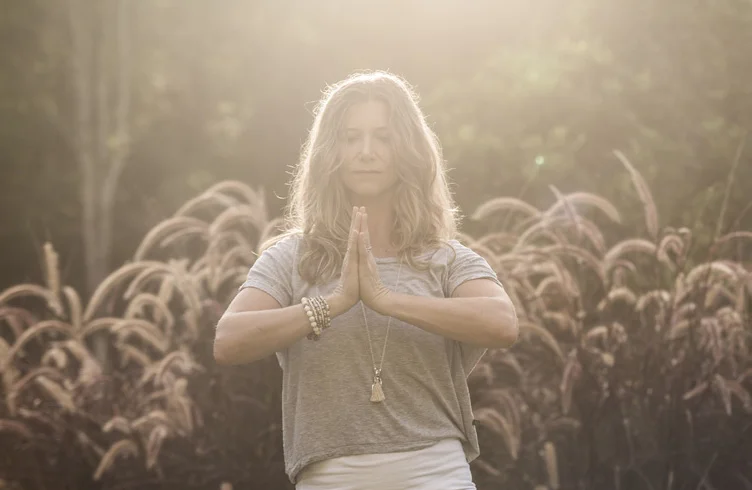Many people discover yoga, or turn to yoga, when they are recovering from illness or injury, or suffering from stress or anxiety or heartbreak, or simply hit rock bottom. While the practices of yoga and meditation may not be a cure-all for devastating diseases, they are widely recognised as healing modalities that can significantly benefit both our physical and mental health.
Long before I became a yoga teacher, I credited my regular dynamic asana practice with keeping me strong and healthy and relatively immune from serious illness. Despite a stressful career and a work hard play hard lifestyle, I rarely got sick. And when I did I recovered quickly from common colds or minor ailments. My mat was all the medication I needed as I manifested one of my favourite phrases, ‘I bend so I do not break’.
Imagine my dismay then that since leaving the corporate world to start my own business and become a full-time yoga teacher, my health seems to have plummeted to an all-time low. In recent years I have been plagued with chest infections, coughs and flu and recently hospitalised for two weeks with a particularly pervasive case of pneumonia, along with complications too numerous to mention.
As a yoga teacher so connected to my breath, it was both a frightening and enlightening experience not being able to fill my lungs with air, or prana as I prefer to think of it. In the darkest hours of my illness I could feel the life force draining from me and there was nothing I could do about it other than surrender to the doctors and nurses and conventional medical wisdom. Eventually, after several days of IV antibiotics, fluids, oxygen and a cocktail of other medications, I was able to walk and breathe again unaided and I was discharged from hospital. I’m now recuperating at home and feeling better and stronger each day, but my return to full health and vitality will be a long, slow process.
It’s not all bad news. My respiratory physician claims my prognosis could have been a lot worse if not for my underlying good health. But I can’t help asking myself how a clean living, health conscious yoga teacher became susceptible to such a serious illness? The doctor says it was just bad luck – a nasty mycoplasma infection contracted on an international flight. Traditional Chinese medicine may identify it as a lung chi deficiency; in Ayurveda it would be attributable to an imbalance in the doshas and an excess of Kapha; or according to the ancient Chakra system a blockage in the heart chakra which is associated with the lungs and the air element.
Whatever the tradition or the diagnosis, I believe that I simply fell into the trap that many of us do all too often. In the busyness of starting and growing my yoga business my own health and wellbeing has taken a back seat. While I used to relish attending regular strong vinyasa classes, in recent years my asana practice has been sporadic, and I have gravitated towards more gentle, yin or restorative styles of yoga. Like any passion that becomes a vocation, I admit it's sometimes hard to find the motivation to get on my mat or attend a class when I have down time. Ultimately, at some point in the last few years I lost my yoga mojo.
The irony of course is that we often learn more real yoga off the mat in difficult circumstances than we do on the mat. The first two limbs of yoga are the yamas and the niyamas, a set of restraints and observances that are fundamental to living a yogic lifestyle, well before we adopt a physical yoga asana practice. Once I was well enough to think clearly, I was reminded in particular of the principles of ahimsa, samtosha, and tapas.
The first, ahimsa, roughly translates as non-violence, or treating yourself and others with compassion and kindness. Being a fiercely independent and capable woman I often find it hard to accept help or allow others to do things for me, but above all this experience has taught me to ask for support when I need it and to receive help gracefully. My husband and my team have been absolutely amazing, and my heart bursts with gratitude for the incredible support network I have around me, both personally and professionally, which enabled me to focus on my recovery in hospital, and which continues to enable me to practice self-care as I recuperate and heal.
Samtosha can be translated as contentment; accepting and being content with what we have in each moment and recognising that every situation has a purpose and a benefit – even if it seems otherwise at the time. I am reminded of the teachings of the Buddha; that pain is an inevitable feature of life, and that it is merely the desire to avoid pain that leads to suffering. Instead of trying to escape or deny difficult experiences, opening to them allows us to experience the deeper nature of being. While it would be easy for me to wallow in self-pity, instead I try to remember that my pain and discomfort is only temporary, and to embrace it in the knowledge that this too will pass.
Last but not least tapas, meaning forbearance or perseverance; not complaining in the face of adversity, but using is as an opportunity to develop strength in both body & mind. As the popular saying goes, what doesn’t kill us makes us stronger. I wholeheartedly admit to shedding more than a few tears of frustration in the past month, but like many of my students and peers I’ve witnessed recovering from serious illness, my motivation to return fitter and stronger than ever before is tremendous. I may not be running a marathon any time soon, but after several weeks hiatus, my yoga mojo is finally back with bells on.
To conclude, many of you will be aware that on top of my illness I have also been dealing with legal complications in relation to one of our studios (hey, it never rains but it pours!). One of my dear students shared a quote on Facebook this week that particularly resonated with me, “You know that great things are coming when everything seems to be going wrong. Old energy is clearing out for new energy to enter. Be patient!” (Idil Ahmed). I honestly believe that in personal and business terms this set-back has been ‘the recession that had to happen’. A market intervention if you like, telling me to slow down, take stock and recalibrate. But there are already signs of a steady recovery, and potential exciting new opportunities that have flowed to me in the past week.
Over the next several weeks you'll be seeing less of me at the front of class as I patiently wait for the old to make way for the new, but more of me on the mat next to you as I reclaim my practice and my health, and prepare for other great things to be revealed. I look forward to sharing them with you!
Blessings,
Amanda

